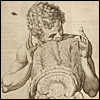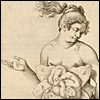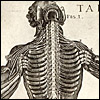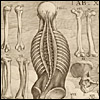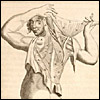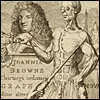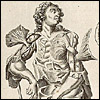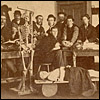
Show-off Cadavers
The anatomy of self display
The emergence of anatomical illustration in the period 1500-1750 coincided with a larger phenomenon, a new definition of personhood that was performed at court, in salons, coffeehouses, country estates, theaters, marketplaces, and at court. Inevitably anatomists took up, commented on, and played with, the contemporary obsession with self-fashioning and individuality—it was an era of manners, wit, foppishness, and coquetry. In the works of Giulio Casserio, John Browne and Pietro da Cortona, the illustrated anatomy book is a stage featuring posing, prancing cadavers. Animated with an exuberant vitality, the corpses perform an anatomical show for the reader’s gaze.
Anatomical
Primitives
Cadavers
at Play
Anatomical Arts and Sciences
Body Part as Body Art
Show-off Cadavers
Next Section : Getting Real
U.S. National Library of Medicine, 8600 Rockville Pike, Bethesda, MD 20894
National Institutes of Health, Department of Health & Human Services
Copyright, Privacy, Accessibility
Last updated: 9 March 2004
|
The Cadaver’s Perspective: Dream Anatomy vs. Anatomical Reality Artists did not just record anatomical reality: they dramatized, travestied, beautified, and moralized it. The gulf between illustration and real life was vast. In Vesalius’s time, and for centuries after, the only legal source of bodies was the gallows. This was insufficient to meet the needs of anatomists, who often stole bodies from burial grounds. But the public regarded graverobbery and dissection as an insult to funerary honor and defended their dead — the dissection of bodies carried a stigma. Families and neighbors stood vigil over the dead and battled bodysnatchers. Anatomists, therefore, tended to take their subjects from the least powerful class of people—convicts, prostitutes, the poor. Illustrators typically suppressed these social origins, but in John Browne’s anatomy the despised lower-class cadaver is perversely transformed into a high-born courtier. |
